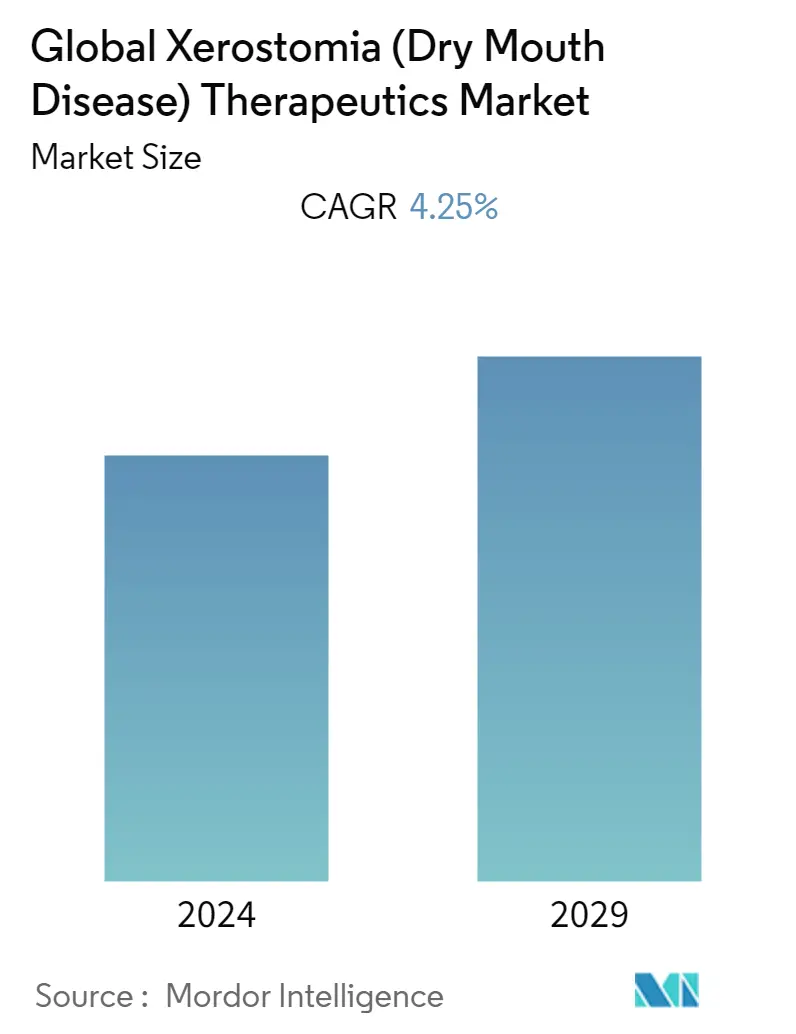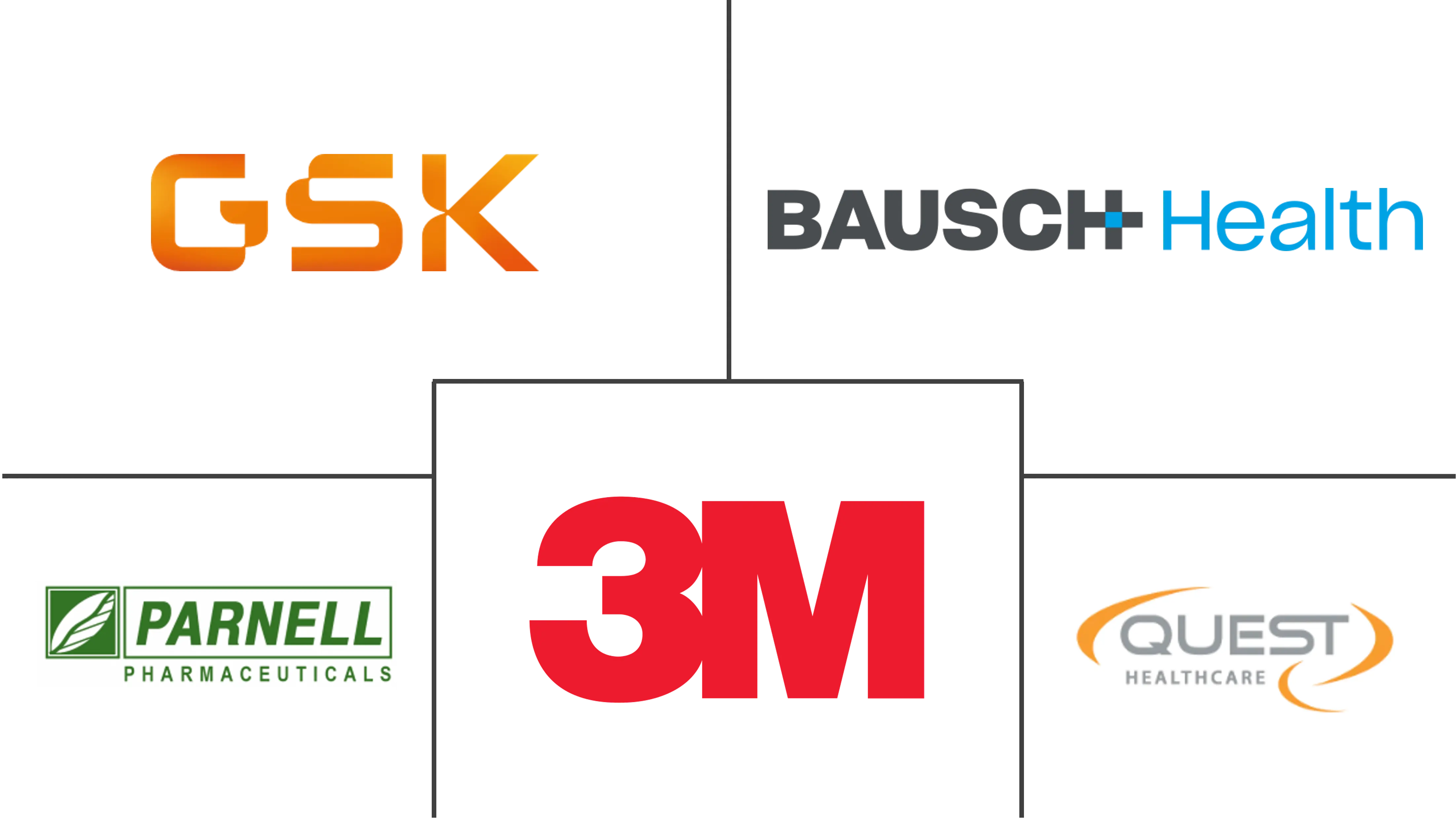Market Size of Global Xerostomia (Dry Mouth Disease) Therapeutics Industry

| Study Period | 2019 - 2029 |
| Base Year For Estimation | 2023 |
| Forecast Data Period | 2024 - 2029 |
| CAGR | 4.25 % |
| Fastest Growing Market | Asia Pacific |
| Largest Market | North America |
Major Players
*Disclaimer: Major Players sorted in no particular order |
Xerostomia Dry Mouth Disease Therapeutics Market Analysis
The Xerostomia (Dry Mouth Disease) Therapeutics market is projected to register a CAGR of 4.25% during the forecast period (2022-2027).
The COVID-19 pandemic has posed new challenges in every aspect of an individual's life, including oral health. Dry mouth has become one of the most common problems that patients from all walks of life are dealing with. COVID-19 has also been linked to dry mouth as a symptom. According to the article titled "Xerostomia (dry mouth) in patients with COVID-19: a case series" published in April 2021, dry mouth appeared in 60% of cases 3-4 days before as a prodromal symptom and in others, simultaneously or 1-2 days after the onset of other symptoms. In the majority of cases, dry mouth improved over time after beginning treatment. The study further stated that in COVID-19 patients, xerostomia may develop before the onset of the common symptoms. Such studies demonstrate the frequency of the condition in COVID-19 patients and hence suggest that the demand for therapeutics for dry mouth disease is anticipated to grow in the near future. Thus, COVID-19 is expected to have a pronounced effect on the growth of the market.
Xerostomia commonly referred to as "dry mouth syndrome", is a result of reduced or absent salivary flow, producing mucosal dryness. The increase in radiation therapy and chemotherapy is likely to lead to an increased incidence of xerostomia, which is estimated to predominantly drive the xerostomia therapeutics market. Other factors driving the market growth include increasing usage of prescription medicines; easy availability and cost-effectiveness of medicines; a growing geriatric population base; and increasing prevalence of diseases, such as Sjogren's syndrome, HIV, diabetes, and Alzheimer's disease, among other diseases.
Additionally, the geriatric population is expected to have a significant impact on the market studied. For instance, according to the World Population Prospect, 2022, globally, in 2022, there were 771 million people aged 65 years or over, and it is projected to reach 994 million by 2030 and 1.6 billion by 2050. Elderly people frequently experience xerostomia, which is typically associated with reduced salivary gland activity. The use of drugs, chronic illnesses, and radiation therapy to the head and neck region have all been implicated as causes of xerostomia in the elderly population.
Furthermore, according to the International Diabetes Federation, as of 2021, there are 536.6 million people aged 20 -79 years around the world living with diabetes, and this number is expected to reach 783.7 million by 2045. Diabetes is often associated with dry mouth syndrome. For instance, as per the article titled "Xerostomia, Salivary Flow, and Oral Health Status Among Saudi Diabetic Patients: A Comparative Cross-Sectional Study" published in the National Library of Medicine in November 2021, Xerostomia was one of the symptoms of diabetes that was most frequently reported. In diabetic patients, xerostomia can occur anywhere between 12.5% and 76.4% of the time. Further, the study detailed that the data from the cross-sectional investigation of 50 diabetic patients in Saudi Arabia was collected, wherein 52% of controls and 60% of the diabetic participants both exhibited xerostomia. Thus, the growing burden of diseases leading to xerostomia is expected to drive the growth of the market.
Thus, the market is expected to experience significant growth over time. However, factors, such as lack of awareness and unavailability of effective treatment, are likely to hinder the usage of xerostomia therapeutics products and can act as a restraining factor for the xerostomia therapeutics market.
Xerostomia Dry Mouth Disease Therapeutics Industry Segmentation
As per the scope of the report, Xerostomia is defined as a dry mouth, resulting from reduced or absent saliva flow. It is not a disease, but it could be a symptom of various medical conditions, a side effect of radiation to the head and neck, or a side effect caused by a wide variety of medications. It may or may not be associated with decreased salivary gland function. The Xerostomia (Dry Mouth Disease) Therapeutics Market is Segmented by Type (Artificial Saliva/Saliva Substitutes, and Salivary Stimulants), Product (Drugs, Salivary Pens, and Other Product Types), Distribution Channel (Hospital Pharmacy, Retail Pharmacy, Online Pharmacy), and Geography (North America, Europe, Asia-Pacific, Middle East and Africa, and South America). The market report also covers the estimated market sizes and trends for 17 different countries across major regions, globally. The report offers the value (in USD million) for the above segments.
| By Type | |
| Artificial Saliva/Saliva Substitutes | |
| Salivary Stimulants |
| By Product | |
| Drugs | |
| Salivary Pens | |
| Other Product Types |
| By Distribution Channel | |
| Hospital Pharmacy | |
| Retail Pharmacy | |
| Online Pharmacy |
| Geography | ||||||||
| ||||||||
| ||||||||
| ||||||||
| ||||||||
|
Global Xerostomia (Dry Mouth Disease) Therapeutics Market Size Summary
The xerostomia therapeutics market is poised for growth, driven by an increasing prevalence of dry mouth syndrome, which is often linked to reduced salivary flow. This condition has gained attention due to its association with COVID-19, where it has been observed as a symptom in many patients. The market is further propelled by the rising incidence of xerostomia due to factors such as radiation therapy, chemotherapy, and the growing geriatric population. The elderly are particularly affected due to reduced salivary gland activity, often exacerbated by chronic illnesses and medication use. Additionally, the prevalence of conditions like diabetes, Sjogren's syndrome, and Alzheimer's disease contributes to the demand for effective therapeutics. The availability of over-the-counter artificial saliva products and ongoing research into their efficacy also supports market expansion.
Regionally, the Asia-Pacific market is expected to experience significant growth due to increasing healthcare expenditure and a high prevalence of diseases that cause dry mouth, such as diabetes and cancer. The region's emerging economies are adopting policies to reduce therapy costs, encouraging the use of chemotherapy and radiotherapy, which are known to induce xerostomia. This creates a heightened demand for therapeutics to manage the condition. The market is moderately competitive, with key players focusing on expanding their product portfolios and geographical presence through strategic acquisitions and partnerships. Innovations in product offerings, such as saliva substitutes and devices providing continuous relief, are also contributing to market dynamics.
Global Xerostomia (Dry Mouth Disease) Therapeutics Market Size - Table of Contents
-
1. MARKET DYNAMICS
-
1.1 Market Overview
-
1.2 Market Drivers
-
1.2.1 Rising Geriatric Population
-
1.2.2 Increasing Adoption of Chemotherapy and Radiotherapy in Cancer Treatment
-
1.2.3 Rising Burden of Diseases, such as Sjogren's Syndrome, HIV, Diabetes, Alzheimer's disease, and Other Diseases
-
-
1.3 Market Restraints
-
1.3.1 Lack of Awareness of Xerostomia in Developing and Underdeveloped Economies
-
1.3.2 Unavailability of Effective Treatment
-
-
1.4 Porter's Five Forces Analysis
-
1.4.1 Threat of New Entrants
-
1.4.2 Bargaining Power of Buyers/Consumers
-
1.4.3 Bargaining Power of Suppliers
-
1.4.4 Threat of Substitute Products
-
1.4.5 Intensity of Competitive Rivalry
-
-
-
2. MARKET SEGMENTATION (Market Size by Value - USD million)
-
2.1 By Type
-
2.1.1 Artificial Saliva/Saliva Substitutes
-
2.1.2 Salivary Stimulants
-
-
2.2 By Product
-
2.2.1 Drugs
-
2.2.2 Salivary Pens
-
2.2.3 Other Product Types
-
-
2.3 By Distribution Channel
-
2.3.1 Hospital Pharmacy
-
2.3.2 Retail Pharmacy
-
2.3.3 Online Pharmacy
-
-
2.4 Geography
-
2.4.1 North America
-
2.4.1.1 United States
-
2.4.1.2 Canada
-
2.4.1.3 Mexico
-
-
2.4.2 Europe
-
2.4.2.1 Germany
-
2.4.2.2 United Kingdom
-
2.4.2.3 France
-
2.4.2.4 Italy
-
2.4.2.5 Spain
-
2.4.2.6 Rest of Europe
-
-
2.4.3 Asia-Pacific
-
2.4.3.1 China
-
2.4.3.2 Japan
-
2.4.3.3 India
-
2.4.3.4 Australia
-
2.4.3.5 South Korea
-
2.4.3.6 Rest of Asia-Pacific
-
-
2.4.4 Middle East and Africa
-
2.4.4.1 GCC
-
2.4.4.2 South Africa
-
2.4.4.3 Rest of Middle East and Africa
-
-
2.4.5 South America
-
2.4.5.1 Brazil
-
2.4.5.2 Argentina
-
2.4.5.3 Rest of South America
-
-
-
Global Xerostomia (Dry Mouth Disease) Therapeutics Market Size FAQs
What is the current Global Xerostomia (Dry Mouth Disease) Therapeutics Market size?
The Global Xerostomia (Dry Mouth Disease) Therapeutics Market is projected to register a CAGR of 4.25% during the forecast period (2024-2029)
Who are the key players in Global Xerostomia (Dry Mouth Disease) Therapeutics Market?
GlaxoSmithKline PLC, Parnell Pharmaceuticals Inc., Bausch Health Companies Inc., 3M company and Quest Products Inc. are the major companies operating in the Global Xerostomia (Dry Mouth Disease) Therapeutics Market.

